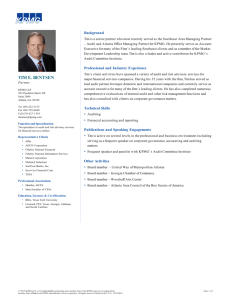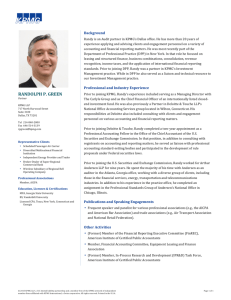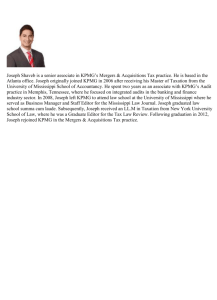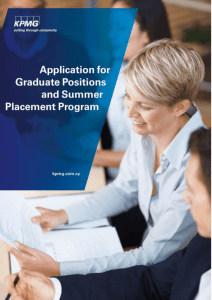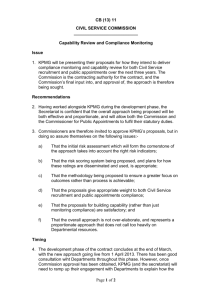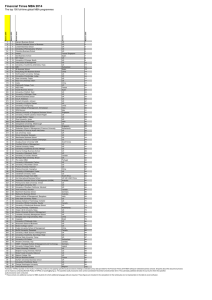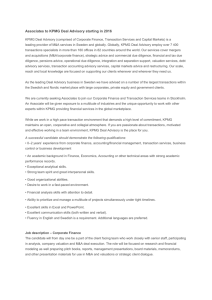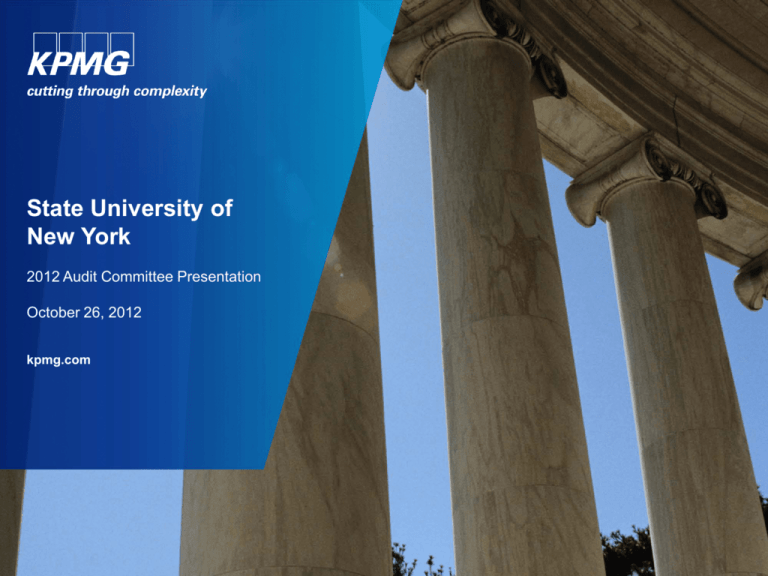
State University of
New York
2012 Audit Committee Presentation
October 26, 2012
kpmg.com
KPMG LLP
515 Broadway
Albany, NY 12207-2974
Telephone
Internet
+1 518 427 4600
www.us.kpmg.com
October 19, 2012
The Members of the Audit Committee
of the State University of New York:
This presentation has been prepared for our meeting with the State University of New York’s (SUNY) Audit Committee on October 26,
2012. Included are required communications of the scope and the preliminary results of our audit of SUNY’s financial statements as of
and for the year ended June 30, 2012. In addition, we have provided control enhancement observations, status of other deliverables and an
update on new accounting matters SUNY will face in future years.
We are pleased to have the opportunity to meet with the members of the Audit Committee to review this information and any other matters
of interest.
Very truly yours,
KPMG LLP
Jane H. Letts
Partner
KPMG LLP is a Delaware limited liability partnership,
the U.S. member firm of KPMG International Cooperative
(“KPMG International”), a Swiss entity.
Table of Contents
Engagement Overview
Required Communications
Audit Approach Recap
Summary of SUNY’s Component Units
Results of Substantive Testing To Date
Consideration of Fraud
Preliminary Management Letter Comments
Preliminary Audit Differences
New Accounting Standards For Future Periods
© 2011 KPMG LLP, a Delaware limited liability partnership and the U.S. member firm of the KPMG network of independent
member firms affiliated with KPMG International Cooperative (“KPMG International”), a Swiss entity. All rights reserved.
71814NYO
3
Engagement Overview
Deliverables
Audit Plan, delivered in May, 2012
Auditors’ report on the basic financial statements
Auditors’ report on internal control and compliance
Management Letter
Significant Matters
Acquisition of Community General Hospital of Greater Syracuse New York
Intercompany loan of $75 million from SUNY to Downstate
Legal Settlement of $167.5 million to Gyrodyne Company of America, Inc.
Defeased existing debt of $1 billion
Implementation of SFS, New York State’s Financial Accounting System
Implementation of new equipment module (Real Asset Management System)
Open Items
Review of final Cornell University Statutory Universities and Alfred University College of Ceramics financial statements
Down to date inquiries and Management representation letter
Final analytical procedures
Review of final SUNY financial statements
© 2011 KPMG LLP, a Delaware limited liability partnership and the U.S. member firm of the KPMG network of independent
member firms affiliated with KPMG International Cooperative (“KPMG International”), a Swiss entity. All rights reserved.
71814NYO
4
Required Communications
These communications are based on our audit testing to date and will be updated, as necessary, upon the completion of our audit.
Requirements Under SAS No. 114
Application to SUNY
Our Responsibility Under Professional Standards
The auditor should communicate to those charged with
governance the level of responsibility assumed under auditing
standards generally accepted in the United States of America
(GAAS) for matters such as internal control and whether the
financial statements are free of material misstatement.
Our primary responsibilities are:
‒ To conduct an independent audit of the financial statements in
accordance with GAAS and the standards applicable to financial audits
contained in Government Auditing Standards, issued by the Comptroller
General of the United States.
‒ To provide independent assurance to the Board of Trustees that the
financial statements prepared by management are presented fairly, in all
material respects, in conformity with U.S. generally accepted accounting
principles (GAAP).
In carrying out our responsibilities under GAAS, we obtained reasonable (but
not absolute) assurance that SUNY’s financial statements are free of material
misstatement and we intend issue an unqualified opinion thereon.
In addition, in planning and performing our financial statement audit, we
considered the SUNYs internal controls in order to determine our auditing
procedures for the purpose of expressing our opinion on the financial
statements. However, an audit does not include examining the effectiveness
of internal controls throughout SUNY and does not provide assurance on
internal controls for SUNY.
We also have a responsibility to communicate significant matters, if any,
related to the financial statement audit that are, in our professional judgment,
relevant to the responsibilities of the Board of Trustees in overseeing the
financial reporting process. However, we are not required to design
procedures for the purpose of identifying other matters to communicate to the
Board of Trustees.
© 2011 KPMG LLP, a Delaware limited liability partnership and the U.S. member firm of the KPMG network of independent
member firms affiliated with KPMG International Cooperative (“KPMG International”), a Swiss entity. All rights reserved.
71814NYO
5
Required Communications (continued)
Requirements Under SAS No. 114
Application to SUNY
Significant Accounting Policies
The auditor should determine that the Board of Trustees is
informed about:
The initial application of significant accounting policies or
changes in their application.
SUNY’s significant accounting policies are summarized in Note 1 to the
financial statements and represent policies prevalent to the financial position
and operations of SUNY.
During 2012, there were no transactions recorded for which there is a lack of
authoritative accounting guidance or consensus.
Significant accounting estimates affecting SUNY’s financial statements
include the following:
The methods used to account for significant and unusual
transactions, and the effect of significant accounting policies
in controversial or emerging areas for which there is a lack of
authoritative guidance or consensus.
Management Judgments and Accounting Estimates
Accounting estimates are an integral part of the financial
statements prepared by management and are based on
management’s current judgments. Certain accounting estimates
are particularly sensitive because of their significance to the
financial statements and because of the possibility that future
events affecting the estimates may differ from management’s
current judgments.
‒ Fair value of investments
‒ Post-retirement benefit obligations
‒ Accounts receivable realization
‒ Medical malpractice claims
The auditor should determine that the Board is informed about:
The process used by management in formulating accounting
estimates.
The basis for the auditor’s conclusions regarding the
reasonableness of those estimates.
We evaluated management’s significant judgments and estimates noted
above as part of our audit, and found them to be reasonable in the context of
the financial statements taken as a whole.
© 2011 KPMG LLP, a Delaware limited liability partnership and the U.S. member firm of the KPMG network of independent
member firms affiliated with KPMG International Cooperative (“KPMG International”), a Swiss entity. All rights reserved.
71814NYO
6
Required Communications (continued)
Requirements Under SAS No. 114
Application to SUNY
Audit Adjustments and Unadjusted Audit Differences
The auditor should inform the Board of Trustees about:
Adjustments arising from the audit that could, in the auditor’s
judgment, either individually or in the aggregate, have a
significant effect on the entity’s financial reporting process.
Passed audit adjustments aggregated by the auditor during
the current audit engagement (and pertaining to the latest
period presented) that were determined by management to be
immaterial, both individually and in the aggregate, to the
financial statements taken as a whole.
We identified no adjustments during the 2012 audit that could, in our
judgment, either individually or in the aggregate, have a significant effect on
SUNY’s financial statements.
Unadjusted audit differences identified do not have a significant impact on
SUNY’s net assets for the year ended June 30, 2012.
We will obtain written representation that management believes the effect of
the unadjusted audit differences are immaterial to the 2012 financial
statements.
Other Information in Documents Containing Audited Financial Statements
The auditor should discuss with the Board of Trustees our
responsibility for other information in documents containing
financial statements, any procedures performed, and the results
thereof.
Our responsibility for other information in documents containing SUNY’s
financial statements and our report thereon does not extend beyond the
financial information identified in our report, and we have no obligation to
perform any procedures to corroborate other information contained in these
documents.
We had no such disagreements with SUNY’s management during our 2012
audit.
Disagreements with Management
The auditor should discuss with the Board of Trustees any
disagreements with management, whether or not satisfactorily
resolved, about matters that individually or in the aggregate
could be significant to the entity’s financial statements or the
auditor’s report.
© 2011 KPMG LLP, a Delaware limited liability partnership and the U.S. member firm of the KPMG network of independent
member firms affiliated with KPMG International Cooperative (“KPMG International”), a Swiss entity. All rights reserved.
71814NYO
7
Required Communications (continued)
Requirements Under SAS No. 114
Application to SUNY
Management’s Consultation with Other Accountants
When the auditor is aware that management has consulted with
other accountants about auditing and accounting matters, the
auditor should discuss with the Board of Trustees his or her
views about such matters.
To the best of our knowledge, management has not consulted with or
obtained opinions (written or oral) from other independent accountants during
the past year concerning matters that were subject to the requirements of
SAS No. 50, Reports on the Application of Accounting Principles.
We generally discuss a variety of matters, including the application of
accounting principles and auditing standards, with management each year.
However, these discussions occurred in the normal course of our
professional relationship, and our responses were not a condition to our
retention as SUNY’s auditors.
We encountered no difficulties in dealing with management during the
performance of our 2012 audit.
Material written communication between management and KPMG include:
Major Issues Discussed with Management Prior to Retention
The auditor should discuss with the Board of Trustees any major
issues that were discussed with management in connection with
the initial or recurring retention of the auditor, including, among
other matters, any discussions regarding the application of
accounting principles and auditing standards.
Significant Difficulties Encountered During the Audit
The auditor should inform the Board of Trustees of any serious
difficulties encountered in dealing with management during the
audit, such as unreasonable delays and timetables, unavailability
of personnel, and failure to provide information on a timely basis.
Material Written Communications
The auditor should ensure the Board is aware of all material
written communications between the auditor and management.
‒ Engagement Letter; and
‒ Management Representation Letter
Independence
The auditor should communicate in writing, at least annually, all
independence-related relationships between the firm and the
client and provide confirmation that the firm is an independent
accountant with respect to the client.
We confirm we are independent accountants with respect to SUNY under all
relevant professional and regulatory standards.
© 2011 KPMG LLP, a Delaware limited liability partnership and the U.S. member firm of the KPMG network of independent
member firms affiliated with KPMG International Cooperative (“KPMG International”), a Swiss entity. All rights reserved.
71814NYO
8
Audit Approach Recap
Campus Audit Approach:
—
Three-tier approach consisting of level 1, level 2 and level 3 campuses.
—
All Level 1 campuses will be visited in year one, level 2 campuses will be visited at least tri-annually. One level 3 campus will be visited per
year
—
Campuses will be reevaluated on an annual basis by considering changes in expenditures levels and other risk factors such as historical audit
(internal and external, KPMG) performance and evolving business transactions.
Campus Visits:
—
Tier 1: Stony Brook (Campus and Hospital), University at Buffalo, Downstate Medical Center
—
Tier 2: Upstate Medical Center, Buffalo College
—
Tier 3: Cobleskill
© 2011 KPMG LLP, a Delaware limited liability partnership and the U.S. member firm of the KPMG network of independent
member firms affiliated with KPMG International Cooperative (“KPMG International”), a Swiss entity. All rights reserved.
71814NYO
9
Summary of SUNY’s Components
Component
Auditor
Audit Scope
SUNY Campuses and Health
Science Centers
KPMG LLP
We visited the campuses listed in our audit plan and designed substantive audit
procedures to obtain sufficient and appropriate audit evidence covering
transactions and amounts reported by campuses and the health science centers.
The Research Foundation of State
University of New York (RF)
KPMG LLP
We placed reliance on the audit report issued over the RF's June 30, 2012 financial
statements.
State University Construction Fund
(Fund)
KPMG LLP
We placed reliance on the audit report issued over the Fund's March 31, 2012
financial statements.
Additionally, we have audited the adjusting entries posted by SUNY to record
capital assets based on the Fund's spending activity.
Cornell (Statutory)
PWC
We received audited financial statements, confirmed independence/objectivity with
auditor, reviewed other auditor's peer review report.
Bonadio & Co. LLP
We received audited financial statements, confirmed independence/objectivity with
auditor, reviewed other auditor's peer review report.
Auxiliary Service Corporations
Various
We received audited financial statements, confirmed independence/objectivity with
auditor, reviewed other auditor's peer review report.
Campus Foundations – Discrete
Component Units
Various
We received audited financial statements, confirmed independence/objectivity with
auditor, reviewed other auditor's peer review report.
Real Estate Holding Corporations
Various
We received audited financial statements, confirmed independence/objectivity with
auditor, reviewed other auditor's peer review report.
Alfred Ceramics (Statutory)
Community Colleges
N/A
Community Colleges are excluded from SUNY's financial reporting entity ,and
therefore, no procedures were performed by KPMG.
© 2011 KPMG LLP, a Delaware limited liability partnership and the U.S. member firm of the KPMG network of independent
member firms affiliated with KPMG International Cooperative (“KPMG International”), a Swiss entity. All rights reserved.
71814NYO
10
Results of Substantive Testing to Date
Key Risks
Revenue recognition
Significant Accounts
Tuition and fees, grants,
hospitals and clinics
Audit Results to Date
Tuition and patient revenues that
are uncollectible
Unsubstantiated disbursements
Accounts receivable
Operating expenses
We selected samples of revenue transactions and obtained source documentation. We
examined revenue transactions for compliance with SUNY and GAAP based revenue
recognition standards.
No exceptions noted.
We reviewed collection history and receivable aging, and tested subsequent cash receipts.
We substantively tested key underlying data used to determine the adequacy of
allowances.
We believe account receivable balances are reasonably valued.
We selected cash disbursements and traced transactions through to the appropriate
general ledger caption. We obtain underlying source documentation, including contract,
PO and invoice.
No exceptions noted.
Assumptions and data underlying
actuarial calculations are invalid
or inaccurate
Actuarially determined
liabilities (including selfinsurance and OPEB
liabilities)
We utilized a KPMG actuary to assist us in assessing key assumptions and methodology.
We substantively tested key underlying data used to determine the liabilities and valuation.
We believe the OPEB valuation was reasonably stated.
Complex financial reporting
process reliant on other
organizations
Investments, Capital Assets,
Payroll, Expenditures
We documented and tested source documentation used in financial statement preparation.
We have confirmed the independence of other auditors.
We noted that the Controllers office has not received certain audited financial statements
used in their reporting process. See management letter comment.
Decentralized control
environment
All accounts and disclosures
We interviewed key operational personnel and evaluate competency. Additionally, we
tested controls for reliance over management review controls.
We believe controls at the campus level would be enhanced through the review and
consideration of service organization SAS 70 reports. See management letter comment.
© 2011 KPMG LLP, a Delaware limited liability partnership and the U.S. member firm of the KPMG network of independent
member firms affiliated with KPMG International Cooperative (“KPMG International”), a Swiss entity. All rights reserved.
71814NYO
11
Consideration of Fraud
“The auditor has a responsibility to plan and perform the audit to obtain reasonable assurance about
whether the financial statements are free of material misstatement, whether caused by error or fraud”
We addressed on our professional responsibility by executing the following procedures:
Management interviews and discussions including existing management fraud controls
Interviews with staff level and management employees
Review of journal entries, including large, unusual and non-recurring journal entries
Assess potential illegal acts or fraud allegations
Consideration of the following risks in the performance of our substantive procedures:
–
Internal pressures
–
Third party pressures
–
Related party transactions
–
Manual journal entries
–
Management bias
Based upon our inquiries and testing to date, no financial statement fraud came to our attention for the period
ending June 30, 2012.
© 2011 KPMG LLP, a Delaware limited liability partnership and the U.S. member firm of the KPMG network of independent
member firms affiliated with KPMG International Cooperative (“KPMG International”), a Swiss entity. All rights reserved.
71814NYO
12
Preliminary Management Letter Comments
Control Deficiencies
Capitalization of Equipment – We identified several equipment additions were capitalized in the incorrect fiscal period.
Capital Assets Placed into Service – We noted that there was a time-lapse in placing certain construction-in-progress
project into service.
Review of SOC 1– SUNY’s campuses utilize third party service organizations to perform student loan account
administration functions. We noted that certain SUNY campus personnel did not obtain and review service organization
SOC 1 reports. However, SUNY System Administration did obtain and review the SOC 1 reports.
Timeliness of Component Reporting –In order to prepare SUNY’s June 30th year-end financial statements, they require
final audited financial statements from various blended and discrete component units. As of October 19, 2012,
approximately 10 entities have not provided audited statements to SUNY.
Additionally, The University Hospital of Brooklyn Foundation has not completed their financial audit for the period ending
July 31, 2011. These financial statements are required to be included in the consolidated Foundation financial statements of
SUNY.
Observations
Centralized Purchases of Services for Third Party Services – Campuses utilize various service organizations to provide
similar functions, such as student billing and electronic pay administration. However the contracts between SUNY and the
service organizations are contracted at the Campus level. SUNY may have a stronger bargaining purchase power if they
centralize their contracts with third parties.
© 2011 KPMG LLP, a Delaware limited liability partnership and the U.S. member firm of the KPMG network of independent
member firms affiliated with KPMG International Cooperative (“KPMG International”), a Swiss entity. All rights reserved.
71814NYO
13
Preliminary Audit Differences
We have identified the following audit differences which we are currently in the process of quantifying:
Debt / Accrued Interest
SUNY records debt information supplied by DASNY at March 31, 2012. Accordingly, accrued interest expense is understated
for the 3-month period April 1st to June 30th. This error is expected to have an inconsequential impact to net assets as a
corresponding understatement in State appropriation revenue/receivable exists. There were no debt issuances made during
the April 1st to June 30th timeframe.
Capital Assets / Deposits with Trustees
SUNY records capital asset information for educational facilities and residence hall facilities as of March 31st. As a result,
capital spending from April 1st to June 30th is excluded from the financial statements. The offset to the understatement of
capital assets is an almost equal offset in deposits held with trustees. We expect this to have an inconsequential impact to net
assets.
Capital Equipment Purchases
SUNY records equipment as it is purchased and placed into service. We reviewed the equipment addition population detail for
the period 2011-12 and identified several items which were capitalized in the incorrect period. Based on our review of the
historical differences and the equipment additions activity which occurred in the first quarter of 2012-13, we expect this to have
an inconsequential impact to net assets.
Summer Tuition
SUNY defers all summer tuition. Accordingly, summer tuition related to the periods on or before June 30th has been
recognized in the subsequent reporting period. As this accounting policy is consistently applied year over year, the rollover
impact is expected to be inconsequential to net assets.
© 2011 KPMG LLP, a Delaware limited liability partnership and the U.S. member firm of the KPMG network of independent
member firms affiliated with KPMG International Cooperative (“KPMG International”), a Swiss entity. All rights reserved.
71814NYO
14
New Accounting Standards For Future Periods
GASB 60 – Accounting and Financial Reporting for Service Concession Arrangements - Effective for June 30, 2013
•
•
•
•
The Statement addresses service concession arrangements (SCAs), which are a type of public-private or public-public partnerships.
The term SCA may include payments from the operator to the government for the right to build, operate, and collect user fees on infrastructure
or other public assets and may provide for revenue sharing between the government and operator during the term of the arrangement.
A transferor reports the facility subject to an SCA as its capital asset. New facilities constructed or acquired by the operator or improvements to
existing facilities made by the operator are reported at fair value by the transferor. A liability is recognized, for the present value of significant
contractual obligations to sacrifice financial resources imposed on the transferor, along with a corresponding deferred inflow of resources.
Revenue is recognized by the transferor in a systematic and rational manner over the term of the arrangement.
The governmental operator reports an intangible asset at cost for its right to access the facility and collect third-party fees; it amortizes the
intangible asset over the term of the arrangement in a systematic and rational manner. For existing facilities, a governmental operator's cost
may be the amount of an up-front payment or the present value of installment payments.
GASB 61 – The Financial Reporting Entity: Omnibus, an amendment to GASB Statements No. 14 and No. 34 – Effective for June 30, 2013
•
•
•
•
Modifies certain requirements for inclusion of component units in the financial reporting entity.
For component units that met fiscal dependency criterion, a financial benefit or burden relation must also be present.
Clarifies inclusion based on management’s determination that it would be misleading to exclude.
Modifies blending criteria based on “substantively the same governing body” would also require primary government and component unit to
have a financial benefit or burden relationship, or management of the primary government have operational responsibilities.
© 2011 KPMG LLP, a Delaware limited liability partnership and the U.S. member firm of the KPMG network of independent
member firms affiliated with KPMG International Cooperative (“KPMG International”), a Swiss entity. All rights reserved.
71814NYO
15
New Accounting Standards For Future Periods, continued
GASB 62 – Codification of Accounting and Financial Reporting Guidance Contained in Pre-November 30, 1989 FASB and AICPA Pronouncements –
Effective June 30, 2013
•
Incorporate into the GASB's authoritative literature certain accounting and financial reporting guidance (FASB and AICPA pronouncements)
issued on or before November 30, 1989, which does not conflict with or contradict GASB pronouncements.
GASB 65 – Reporting Items Previously Recognized as Assets and Liabilities – Effective June 30, 2014
•
•
Reclassifies and recognizes, as deferred outflows of resources or deferred inflows of resources, certain items that were previously reported as
assets and liabilities.
This will result in the immediate expensing of bond issuance costs.
GASB 66 – Technical Corrections – 2012 , an amendment of GASB Statements No. 10 and No. 62 – Effective June 30, 2014
•
•
Amendment to Statement No. 10 removes provision that limit fund-based reporting of an entity's risk financing activities to the general fund and
the internal service fund type.
Amendment to Statement No. 62 modifies the specific guidance on accounting for (1) operating lease payments that vary from a straight-line
basis, (2) the difference between the initial investment (purchase price) and the principal amount of a purchased loan or group of loans, and (3)
servicing fees related to mortgage loans that are sold when the stated service fee rate differs significantly from a current (normal) servicing fee
rate.
GASB 67 – Financial Reporting for Pension Plans – Effective June 30, 2014
•
Addresses financial reporting for state and local government pension plans.
GASB 68 – Accounting and Financial Reporting for Pensions – Effective June 30, 2015
•
Establishes new accounting and reporting requirements for governments that provide pensions to their employees.
© 2011 KPMG LLP, a Delaware limited liability partnership and the U.S. member firm of the KPMG network of independent
member firms affiliated with KPMG International Cooperative (“KPMG International”), a Swiss entity. All rights reserved.
71814NYO
16
© 2011 KPMG LLP, a Delaware limited liability partnership and
the U.S. member firm of the KPMG network of independent
member firms affiliated with KPMG International Cooperative
(“KPMG International”), a Swiss entity. All rights reserved.
71814NYO
The KPMG name, logo and “cutting through complexity” are
registered trademarks or trademarks of KPMG International.

